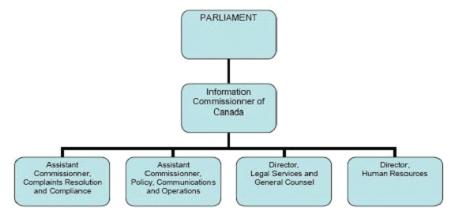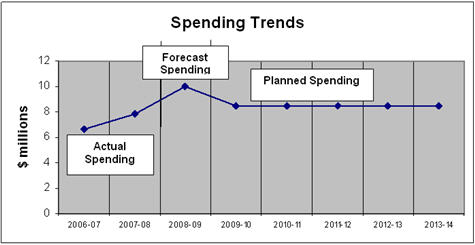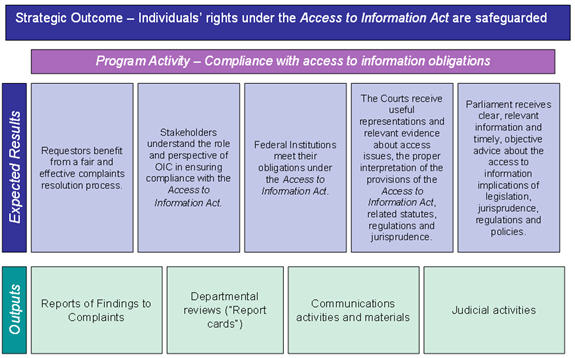ARCHIVED - Office of the Information Commissioner of Canada
 This page has been archived.
This page has been archived.
Archived Content
Information identified as archived on the Web is for reference, research or recordkeeping purposes. It has not been altered or updated after the date of archiving. Web pages that are archived on the Web are not subject to the Government of Canada Web Standards. As per the Communications Policy of the Government of Canada, you can request alternate formats on the "Contact Us" page.
2009-10
Report on Plans and Priorities
Office of the Information Commissioner of Canada
The original version was signed by
Robert Marleau
Information Commissioner of Canada
The Honourable Robert Douglas Nicholson, PC. QC, M.P.
Minister of Justice and Attorney General of Canada
Table of Contents
Message from the Information Commissioner of Canada
- 1.1 Summary Information
- Raison d’être
- Responsibilities
- Strategic Outcome
- Program Activity Architecture
- 1.2 Planning Summary
- Financial Resources
- Human Resources
- Contribution of Priorities to Strategic Outcomes
- Risk Analysis
- Expenditure Profile
- Voted and Statutory Items
Section II: Analysis of Program Activities by Strategic Outcome
Message from the Information Commissioner of Canada

I am pleased to present this 2009-2010 Report on Plans and Priorities which outlines the strategic objectives, expected results and spending estimates for the Office of the Information Commissioner (OIC) for the coming fiscal year.
The progress made last year to remodel and improve the Office’s internal operations has set the stage for broader, more far-reaching work to be done in the year ahead to modernize the access to information system as a whole.
Substantial changes have now taken place within the Office to restructure and re-organize our investigations and internal services processes. This was necessary to put the Office on a surer path to resolve complaints in a timely manner and meet the increased challenges of today’s access to information climate.
However, it is important that we now make a further leap forward to raise our standards of service and address the challenges facing federal institutions in providing efficient and transparent access to information. This will allow us to fully and efficiently carry out the mandate which Parliament has given this Office.
Our vision is to become ‘best in class’ by achieving excellence as an ombudsman for Access to Information; as an investigative body in resolving complaints; and as an employer. The Office has identified some specific priorities to bring us closer to making this a reality.
I look forward to working collaboratively and fostering good relations with all the players in the access to information system —from requesters, to complainants, to access professionals, to institutions and to Parliament— to achieve our priorities while promoting better stewardship of the system and greater openness in government.
Robert Marleau
Information Commissioner of Canada
Section I: Overview
1.1 Summary Information
Raison d’être
The raison d’être of the Office is to ensure that the rights conferred by the Access to Information Act are respected; that complainants, heads of federal institutions and all third parties affected by complaints are given a reasonable opportunity to make representations to the Information Commissioner; to persuade federal institutions to adopt information practices consistent with the objectives of the Access to Information Act; and to bring appropriate issues of interpretation of the Access to Information Act before the Federal Court. The Office also advocates for greater access to information in Canada and promotes Canadians’ right to access information held by federal institutions.
Responsibilities
The Information Commissioner reviews the complaints of individuals and organizations who believe that federal institutions have not respected their rights under the Act. The Commissioner also advocates for access to information in Canada and for transparent and open government. The Information Commissioner is supported in his work by the Office of the Information Commissioner, an independent public body set up in 1983 under the Access to Information Act to respond to complaints from the public about access to information held by federal institutions. The Office has four branches:
The Complaints Resolution and Compliance Branch carries out investigations and dispute resolution efforts to resolve complaints.
The Policy, Communications and Operations Branch monitors federal institutions’ performance under the Act, provides strategic advice and direction for the Office to address systemic and policy issues, leads the Office’s external relations with the public, the government and Parliament, and provides strategic and corporate leadership in the areas of financial management, administration and security, internal audit and information management. This Branch is also responsible for the OIC’s ATIP function.
The Legal Services Branch represents the Commissioner in court cases and provides legal advice on investigations, and legislative and administrative matters.
The Human Resources Branch oversees all aspects of human resources management staffing, classification, staff relations, employment equity, planning, learning and development, compensation and official languages, and provides advice to managers and employees on human resources issues.
The organizational structure of the Office of the Information Commissioner is shown in the diagram below.

Strategic Outcome
In order to effectively pursue its mandate, the Office aims to achieve the following strategic outcome:
Individuals’ rights under the Access to Information Act are safeguarded
Program Activity Architecture
The chart below illustrates the Office of the Information Commissioner’s program activity, which contributes to progress toward the Office’s Strategic Outcome.
Compliance with access to information obligations
1.2 Planning Summary1
| 200910 | 2010-11 | 2011-12 |
|---|---|---|
| 8,505 | 8,505 | 8,505 |
The financial resources table above provides a summary of the total spending for the Office of the Information Commissioner for the next three fiscal years.
1 In 2008, the Office of the Information Commissioner has conducted an in-depth review of its funding. The results of this strategic review will be submitted to the Advisory Panel on the Funding and Oversight of Officers of Parliament in 2009 for subsequent analysis. The results will be reflected in future reporting to Parliament.
| 200910 | 2010-11 | 2011-12 |
|---|---|---|
| 82 | 82 | 82 |
The human resources table above provides a summary of the total planned human resources for the Office of the Information Commissioner for the next three fiscal years.
| Strategic Outcome 1 (SO1): Individuals’ rights under the Access to Information Act are safeguarded | |||||||
|---|---|---|---|---|---|---|---|
| Performance indicators | Targets | ||||||
| See Section 2.1.1 for more details | |||||||
| Program Activity2 | Expected Results |
|
|
||||
| 2008-09 | 2009-10 | 2010-11 | 2011-12 | ||||
| Compliance with access to information obligations | See Section 2.1.1 for more details | 9,963 | 8,505 | 8,505 | 8,505 | ||
| Total Planned Spending | 9,963 | 8,505 | 8,505 | 8,505 | |||
| Management Priorities | Type | Description |
|---|---|---|
| Build organizational capacity | Previously committed to | The Office will continue to improve its ability to deliver services to Parliament, federal institutions and Canadians by focussing on strengthening investigative, support services, administrative and corporate capabilities. Emphasis will be put on recruitment, training and retention of resources. |
| Alignment of IM/IT with business needs and values | New | In order to effectively support the OIC’s new business model and program delivery, the Office will continue to implement a multi-year in-depth IM/IT renewal strategy to modernize its systems in order to provide investigators with more effective tools to meet workload targets for investigations, to deliver on its ATIP responsibilities and to provide high levels of service expected from Canadians. |
| Planning and reporting | New | The Office will continue to streamline and integrate its planning and reporting instruments, including management planning, business planning and corporate planning and reporting. The linkage between strategic objectives, operational planning and performance management are not always well defined across the organization. Planning and reporting will be aligned with the Program Activity Architecture with an increased emphasis on performance management and measurement. |
2 For program activity descriptions, please access the Main Estimates online at: http://www.tbs-sct.gc.ca/est-pre/estime.asp
3All operational and management priorities contribute to the sole OIC strategic outcome.
Risk Analysis
The introduction of the Federal Accountability Act (FedAA) continues to have a major impact on the access to information community including the Office. With the addition of 70 federal institutions now subject to the Act, there is a shortage of qualified resources across the government. Many investigators left the Office during the year for ATIP related positions in other federal institutions. As a result, the Complaint Resolution and Compliance Branch is currently operating at about 50% capacity despite ongoing recruiting efforts. Nonetheless, the Office is in the process of staffing these positions, drawing on various skill sets and experience. Large resource investments in recruitment, training and retention are expected.
In the last few years, the Office has reported a continuing and persistent backlog of cases. The situation did not improve despite considerable efforts to reduce the backlog. The total number of complaints received by the OIC reached 2,387 in 2007-08, representing a spike of over 80% in the number of complaints from the previous year.
On September 1, 2008, the inventory of cases consisted of over 2,800 cases with approximately 35% of cases older than 1 year and 67% of cases older than 6 months. The Office has recognized that its current business model and processes are not sustainable. In keeping with its current strategy to streamline and improve investigative processes coupled with the commitment to significantly reduce or eliminate the historical backlog of cases by the end of 2009-2010, the Office has put in place a new case workload management model. The Office is committed to provide a high level of client service while ensuring compliance with the Access to Information Act and ensuring that Canadians’ rights under the Act are respected.
The Office made significant operational and management changes in the previous fiscal year. While progress has been made in a number of areas, there continues to be capacity shortfall in key functions including investigations, HR, communications, advocacy, and parliamentary relations. The Office undertook a review of operations and funding levels in 2008. Preliminary conclusions of the Review support the need for additional resources to enable the OIC to deliver on its mandate. To date, the resource level available is such that it is not possible to address all issues in the short term; therefore, issues will be addressed on a priority basis.
Expenditure Profile
For the 2009-10 fiscal year, the Office of the Information Commissioner plans to spend 8.505 millions to meet the expected results of its program activity and contribute to its strategic outcome.
In 2008-09, the Office of the Information Commissioner conducted an in-depth review of the funding, relevance and performance of all its activities and spending to ensure results and value for money for Canadians. The results of this strategic review will be submitted to the Advisory Panel on the Funding and Oversight of Officers of Parliament in 2009 for subsequent analysis. The results will be reflected in future reporting to Parliament.
The figure below illustrates the Office of the Information Commissioner’s spending trends from 2006-07 to 2013-14.

For the 2006-07 to 2008-09 periods, total spending includes all parliamentary appropriation. It also includes carry forward adjustments. For the 2010-11 to 2013-14 periods, total spending corresponds to planned spending. Supplementary funding and carry forward adjustments are unknown at this point and therefore not reflected.
Since 2006-07, the Office’s core spending increased due to new funding received to address the backlog inventory, to comply with the requirements of the FedAA and to establish an internal audit function as required by the Treasury Board Audit Policy. The funding for the backlog will sunset at the end of fiscal year 2008-09.
All financial and non-financial resources are dedicated to the OIC sole program activity.
Voted and Statutory Items
This table illustrates the way in which Parliament approved OIC resources, and shows the changes derived from supplementary estimates and other authorities, as well as how funds were spent.
| Vote # or Statutory Item (S) | Truncated Vote or Statutory Wording | 2008-09 Main Estimates |
2009-10 Main Estimates |
|---|---|---|---|
| 40 | Program expenditures | 6,733 | 7,540 |
| (S) | Contribution to employee benefit plans | 932 | 965 |
| Total | 7,665 | 8,505 | |
Section II: Analysis of Program Activities by Strategic Outcome
2.1 Strategic Outcome
The following section describes the Office’s sole program activity and identifies the expected results, performance indicators and targets for each of them. This section also explains how the Office plans on meeting the expected results and presents financial and non-financial resources that will be dedicated to the sole program activity.
2.1.1 Program Activity: Compliance with access to information obligations

| Performance Indicators | Targets |
|---|---|
| Quality and timeliness of the investigation process (including investigation, legal review, approval and report of findings) | 90% of investigations adhere to quality assurance standards at first round of review |
| Reach to, and feedback from, stakeholders (i.e., the public, requesters, ATIP Coordinators community, other) through: public events, speaking engagements, access to proper web-based and other tools and information | Stakeholders reached through having ready access to the Office’s publications, tools and information namely via a Web site that is redesigned to be comprehensive, up-to-date and user-friendly; and stakeholders feedback generally positive |
| Proportion of investigation recommendations that are adopted and proportion of Report Card recommendations that are adopted | 95% of complaints investigation recommendations are adopted and 80% of Report Card recommendations are adopted |
| Proportion of court cases where judgments support OIC representation (either to sustain or clarify interpretation of related statutes) and/or where OIC evidence was considered as part of court deliberations | 90% of court judgments either support OIC representation and/or consider OIC evidence |
| Value of OIC information and advice provided to Parliamentarians and Parliamentary Committees | 80% of information access-relevant Parliamentary Committee reports refer to OIC advice; positive feedback from Parliamentarians, Committee Chairs and members |
| Financial Resources ($ thousands) | Human Resources (FTEs) | |||||
|---|---|---|---|---|---|---|
| 2009-10 | 2010-11 | 2011-12 | 2009-10 | 2010-11 | 2011-12 | |
| 6,230 | 6,230 | 6,230 | 59 | 59 | 59 | |
Program Activity Summary: The Access to Information Act is the legislative authority for the oversight activities of the Information Commissioner of Canada, which are: to investigate complaints from individuals and corporations; to review the performance of federal institutions; to report results of investigations/reviews and recommendations to complainants, federal institutions, and Parliament; to pursue judicial enforcement and to provide advice to Parliament on access to information matters.
Planning Highlights: In order to achieve the expected results, the Office plans to undertake the following activities:
- Fully implementing a new case workload management model. The OIC has devised a backlog strategy to be fully implemented in 2009-10. In 2008-09 a comprehensive review of the complaints handling process will be completed. The Office has already determined that benefits can be attained from a dedicated intake function and an early resolution function. These two new functions are being implemented on a pilot basis in 2008-09.
- The OIC will be adopting a renewed approach to performance reviews of institutions, addressing broad systemic issues and disseminating best practices. The new reports cards will accurately reflect ongoing efforts by institutions to improve compliance and the process will be linked to the fiscal year performance management framework. The OIC will report on federal institutions’ performance and systemic issues in a Special Report to Parliament.
- Fostering good relations with all the players in the access to information system—from requesters, to complainants, to access professionals, to institutions and to Parliament. The OIC will be promoting, through systemic investigations and communication activities, for increased and sustainable government-wide compliance with the ATIA.
- Focus on recruitment, training and retention. The OIC faces significant HR challenges in delivering on its mandate. Attracting, recruiting, training a highly skilled investigator workforce is becoming a priority. The potential shortage of investigators may become a key obstacle to meeting targets over the next several years.
Benefits for Canadians: This program activity which represents the mandate of the Office helps to ensure that federal institutions comply with access to information obligations contained in the Access to Information Act. It encourages federal institutions to make information more easily available to the public and helps to keep the federal government accountable to Canadians. Overall, this program activity contributes to an open, transparent and accountable government.
2.1.2 Program Activity: Internal Services
Internal Services are groups of related activities and resources that are administered to support the needs of programs and other corporate obligations of an organization. These groups are: Management and Oversight Services; Communications Services; Human Resources Management Services; Financial Management Services; Information Management Services; Information Technology Services; Material Services; Acquisition Services; Travel and Other Administrative Services. Internal Services include only those activities and resources that apply across an organization and not those provided specifically to a program.
| Financial Resources ($ thousands) | Human Resources (Full-time Equivalents) | |||||
|---|---|---|---|---|---|---|
| 2009-10 | 2010-11 | 2011-12 | 2009-10 | 2010-11 | 2011-12 | |
| 2,275 | 2,275 | 2,275 | 23 | 23 | 23 | |